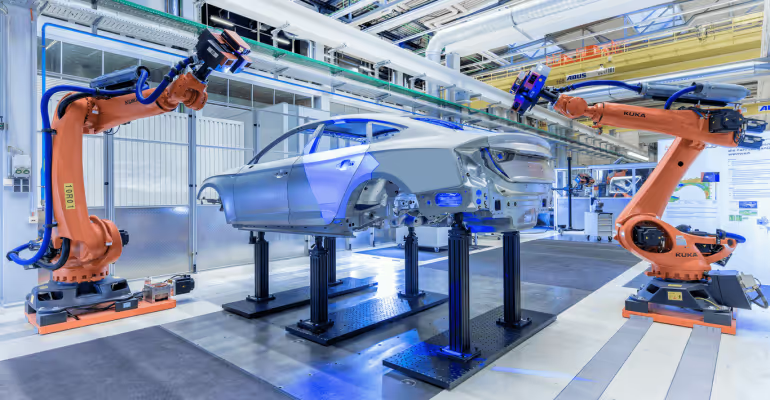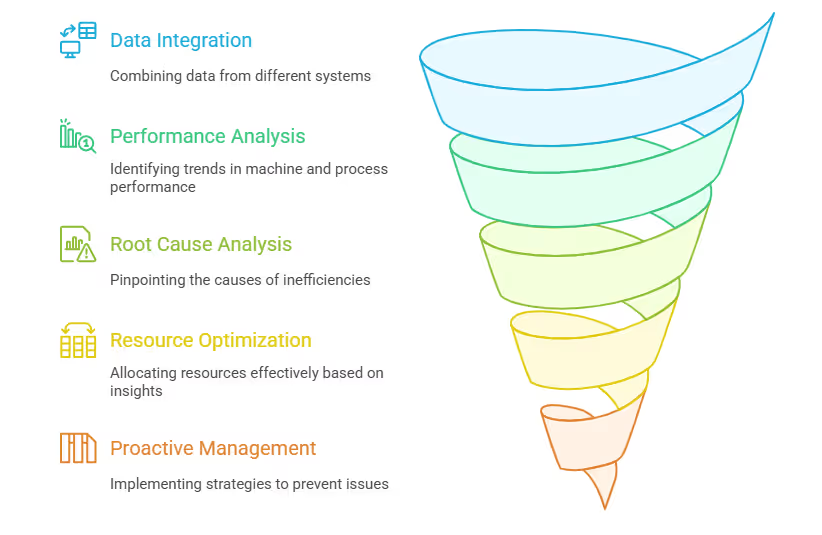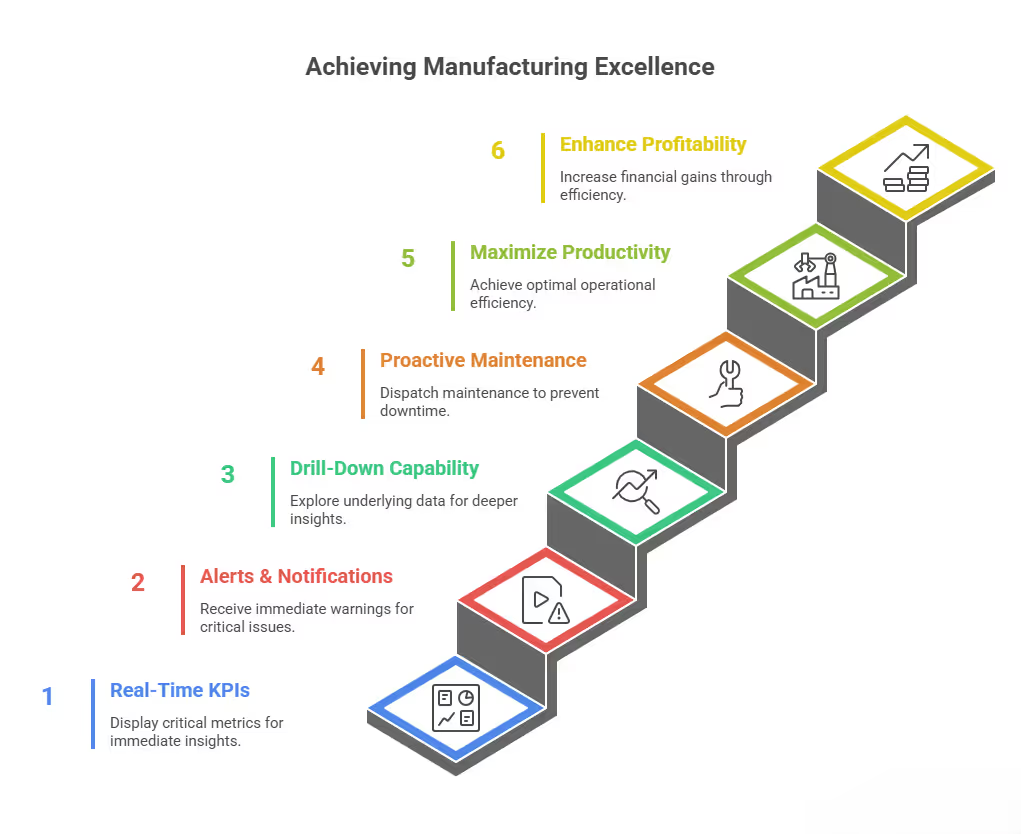Smart shop floor – U.S. Factories Are Getting Smarter

Shop Floor Analytics for American Manufacturers
Table of Contents
- Shop Floor Data Collection
- Shop Floor Analytics and Data Analytics: Decoding Operations
- Shop Floor Management: Mastering Production Flow
- Shop Floor Dashboard: Visualizing Sucess
- Industry-Wide Intelligence: Manufacturing Analytics
- Real-Time Shop Floor Monitoring
- Shop Floor Automation: Embracing The Future
- The IoT Backbone: Shop Floor IoT
- Streamlining Production: Production Line Analytics
- Measuring Success: Manufacturing KPI Dashboard
- Proactive Maintenance: Predictive Maintenance Manufacturing
In my seven years as an IoT developer, specializing in industrial automation across more than 30 projects, I’ve seen firsthand the transformative power of data when applied to manufacturing. Especially for American companies, the push for greater efficiency and competitive edge is not just a trend; it is a necessity. We often hear about "smart factories," but what does that truly mean for your operations in the USA? It means moving beyond fragmented data and toward a cohesive, intelligent system that offers unprecedented insights.
This blog post guides company owners seeking shop floor automation in the U.S. through the essentials of building an intelligent shop floor, from data collection to predictive insights, using real-world industry examples.
A smart shop floor uses IoT, real-time data, and advanced analytics to optimize production, reduce downtime, and enhance decision-making for U.S. manufacturers.
The Foundation: Shop Floor Data Collection
For any American manufacturer looking to enhance operations, the journey to a smarter shop floor starts with robust shop floor data collection. Without accurate and timely data, even the most sophisticated analytics tools remain useless.
Think of it as your factory's nervous system: every sensor, every machine, every operator input contributes to a comprehensive picture of your production environment.

Why Data Collection Matters for U.S. Manufacturers
- Identify Bottlenecks: Manual tracking often misses subtle inefficiencies. Automated data collection highlights exact points of slowdown.
- Improve OEE (Overall Equipment Effectiveness): To truly understand machine performance, you need precise data on availability, performance, and quality.
- Ensure Compliance and Reporting: For U.S. regulations, accurate and auditable data is essential. Digital records significantly simplify this process.
Key Data Points You Should Collect
When we discuss shop floor data collection, we mean more than just basic production counts. We look at a holistic view:
- Machine Status: Run time, idle time, and reasons for downtime (e.g., maintenance, material shortage, changeover).
- Production Counts: Real-time units produced, rejected, and rework quantities.
- Energy Consumption: Data on power usage per machine or production line can reveal hidden costs.
- Environmental Factors: Temperature, humidity, and vibration, particularly for sensitive processes.
- Operator Performance: Non-intrusive data on task completion times and adherence to Standard Operating Procedures (SOPs).
Companies like Rockwell Automation provide FactoryTalk® ProductionCentre MES, which offers comprehensive data collection tools tailored for U.S. manufacturing environments. This enables detailed tracking from raw material to finished product.
Decoding Operations: Shop Floor Analytics and Data Analytics
Once you have the data, the next step is to make sense of it. This is where shop floor analytics and shop floor data analytics become crucial. It is the difference between collecting raw ingredients and preparing a gourmet meal.
For U.S. company owners, translating raw data into actionable insights drives competitive advantage.
From Raw Data to Actionable Insight
- Performance Trends: Identify patterns in machine uptime, defect rates, and throughput over time.
- Root Cause Analysis: Pinpoint the exact reason for deviations or inefficiencies, rather than just knowing they exist.
- Resource Optimization: Understand where human and machine resources are best utilized or underutilized.
How Shop Floor Data Analytics Empowers You
Advanced shop floor data analytics platforms can integrate data from various sources (PLCs, ERP systems, manual inputs) to provide a unified view.
For instance, analyzing machine vibration data (collected via IoT sensors) can predict impending machine failures. This allows for proactive maintenance rather than reactive shutdowns. This capability alone saves U.S. manufacturers significant costs in lost production.
Mastering Production Flow: Shop Floor Management
Effective shop floor management means orchestrating people, processes, and technology to achieve peak operational efficiency. In the U.S. manufacturing landscape, where labor costs can be higher and global competition fierce, optimizing every aspect of management is paramount.
A smart shop floor empowers managers with real-time insights, transforming their role from reactive problem-solvers to proactive strategists.
Intelligent Shop Floor Management in Action
- Real-time Visibility: Know exactly what happens on the production line at any given moment.
- Automated Workflow: Use data to trigger actions, such as reordering materials or scheduling maintenance.
- Performance Monitoring: Track KPIs and instantly identify deviations from targets.
Tools That Enhance Shop Floor Management
Modern shop floor management systems often integrate with Manufacturing Execution Systems (MES). These provide a digital backbone. Siemens Opcenter MES, for example, offers modules for production management, quality management, and material management. All are designed to give U.S. manufacturers a holistic view and control over their operations. By centralizing data and control, managers make faster, more informed decisions, reducing wasted time and resources.
Visualizing Success: The Shop Floor Dashboard
What good is data if you cannot see it clearly? A well-designed shop floor dashboard serves as the command center for any smart factory. It translates complex data into intuitive visuals, allowing company owners and managers in the U.S. to grasp the pulse of their operations at a glance.
For companies seeking shop floor automation, the dashboard often provides the first tangible benefit they experience.

What Belongs on an Effective Shop Floor Dashboard
- Real-Time KPIs: Display critical metrics like OEE, throughput, defect rates, and cycle times.
- Alerts and Notifications: Get immediate warnings for critical issues like machine breakdowns or quality deviations.
- Drill-Down Capability: Click on a metric to explore the underlying data for deeper insights.
Impact on U.S. Manufacturing Operations
Imagine a plant manager in a Texas factory seeing a red alert on their shop floor dashboard indicating a critical machine operates below its performance threshold. They immediately drill down to identify the specific machine, its historical performance, and even potential causes.
This allows them to dispatch maintenance proactively.
This proactive approach, enabled by a real-time dashboard, minimizes downtime and maximizes productivity, directly impacting profitability in the competitive U.S. market.
Leading providers like Hakuna Matata Tech offer customized shop floor production dashboards that provide tailored insights for different manufacturing sectors.
Industry-Wide Intelligence: Manufacturing Analytics
While shop floor analytics focuses on a specific area, manufacturing analytics takes a broader view. It encompasses the entire operational landscape from supply chain to customer delivery. For U.S. company owners, this macro perspective is crucial for strategic decision-making, market positioning, and long-term growth.
It helps you understand not just how your shop floor performs, but how it contributes to your overall business objectives.
The Broad Scope of Manufacturing Analytics
- Supply Chain Optimization: Analyze supplier performance, lead times, and inventory levels to reduce costs and improve responsiveness.
- Quality Management: Identify trends in defects across product lines or batches, leading to process improvements.
- Demand Forecasting: Use historical data and market trends to predict future demand, optimizing production schedules.
Drive Strategic Decisions with Manufacturing Analytics
For example, a manufacturing analytics platform might reveal that a particular raw material consistently causes issues on the production line, leading to higher scrap rates. This insight allows a U.S. manufacturer to negotiate better terms with the supplier or seek alternative materials, directly impacting their bottom line.
Data-driven strategic decisions, powered by comprehensive analytics, are a hallmark of successful U.S. manufacturing businesses in the 21st century.
Companies like SAS and IBM offer robust manufacturing analytics solutions that can integrate data from various enterprise systems, providing a holistic view of operations for U.S. businesses.
Real-Time Shop Floor Monitoring
When seeking shop floor automation companies in the USA, real-time shop floor monitoring is essential. It provides immediate visibility into every aspect of production, allowing for instantaneous responses to issues and proactive optimization.
As an IoT developer, I have seen how this capability transforms reactive troubleshooting into predictive problem-solving, dramatically improving efficiency for American factories.
Components of Effective Real-Time Shop Floor Monitoring
- Sensor Integration: Deploy IoT sensors on machines, production lines, and even raw materials to collect continuous data.
- Data Streaming: Ensure data flows seamlessly from the shop floor to analytics platforms.
- Alert Systems: Get automated notifications for deviations, anomalies, or critical events.
Gain a Competitive Edge in the U.S. Market
Imagine a scenario where a machine tool in a Michigan plant experiences a sudden drop in output. With real-time shop floor monitoring, the system immediately flags the anomaly, alerting maintenance personnel before the issue escalates into a complete breakdown. This capability reduces unplanned downtime, a major cost for U.S. manufacturers. Furthermore, it allows for continuous process improvement by identifying subtle inefficiencies that would otherwise go unnoticed. This is the essence of smart manufacturing, where data empowers swift, informed action.
Embracing the Future: Shop Floor Automation
Shop floor automation means more than just replacing manual labor with machines; it means integrating intelligent systems that optimize processes, improve quality, and enhance safety. For company owners in the U.S. aiming for higher productivity and reduced operational costs, automation is a strategic imperative. As an IoT developer, I see automation as the logical outcome of effective data collection and analytics.
Benefits of Shop Floor Automation for U.S. Manufacturers
- Increase Throughput: Automated systems operate continuously and consistently, leading to higher production volumes.
- Improve Quality: Reduce human error, leading to more consistent product quality and fewer defects.
- Enhance Worker Safety: Automate hazardous or repetitive tasks, minimizing risks for employees.
- Reduce Cost: Achieve long-term savings through reduced labor costs, lower energy consumption, and less waste.
How Data Powers Shop Floor Automation
Data collected from the shop floor directly informs automation systems. For example, production data can automatically adjust machine parameters for optimal output based on material characteristics. Or, a defect detection system can trigger automated rejection of faulty products.
The synergy between data and automation creates a self-optimizing production environment, a key objective for competitive U.S. manufacturing. Companies like ABB Robotics and FANUC provide advanced robotic solutions that lead shop floor automation in the U.S.
The IoT Backbone: Shop Floor IoT
At the heart of the smart factory revolution lies shop floor IoT. The Internet of Things (IoT) provides the critical infrastructure for connecting machines, sensors, and systems, enabling the flow of real-time data essential for advanced analytics and automation.
For U.S. company owners considering shop floor automation, understanding the role of IoT is paramount, as it forms the very foundation upon which intelligent operations are built.
How Shop Floor IoT Transforms Manufacturing
- Ubiquitous Connectivity: Connect disparate machines and devices, regardless of their age or vendor.
- Data Generation: Sensors attached to machines, tools, and even products generate vast amounts of operational data.
- Remote Monitoring: Oversee factory operations from anywhere, enhancing flexibility and responsiveness.
Real-World Impact in the U.S.
Consider a large-scale manufacturing plant in California. By deploying shop floor IoT sensors, they monitor the temperature of critical components in their machinery, predicting potential failures before they occur. This predictive capability, powered by IoT, dramatically reduces unplanned downtime and maintenance costs. Furthermore, IoT tracks the movement of goods and materials throughout the factory, optimizing logistics and reducing bottlenecks. The insights gained from shop floor IoT are invaluable for driving efficiency and innovation in U.S. manufacturing. Platforms like PTC ThingWorx and GE Predix offer comprehensive IoT solutions tailored for industrial applications.
Streamlining Production: Production Line Analytics
Production line analytics applies data analysis specifically to optimize the efficiency and output of individual production lines. While shop floor analytics is broader, this deeper dive provides granular insights crucial for continuous improvement. For American manufacturers, bottlenecks on a single line significantly impact overall output, making this level of analysis incredibly valuable.
Key Benefits of Production Line Analytics
- Bottleneck Identification: Pinpoint the exact machines or processes causing delays on a line.
- Cycle Time Optimization: Reduce the time it takes to produce a single unit, leading to higher throughput.
- Waste Reduction: Identify and eliminate inefficiencies that lead to material waste or rework.
Practical Application for U.S. Operations
A manufacturer in North Carolina might use production line analytics to discover a specific assembly station frequently experiences delays due to tool changeovers.
By analyzing this data, they implement process changes, tool standardization, or even automated tool changers to reduce this delay, thereby increasing the line's overall efficiency.
This granular optimization, driven by data, directly leads to increased profitability and competitiveness in the U.S. market.
Measuring Success: Manufacturing KPI Dashboard
A manufacturing KPI dashboard is an indispensable tool for any U.S. company owner committed to data-driven decision-making. KPIs (Key Performance Indicators) are specific, measurable metrics that reflect the health and performance of your manufacturing operations. A well-designed dashboard provides a clear, concise overview of these critical numbers, allowing for quick assessment and informed action.
Essential KPIs for Your Manufacturing KPI Dashboard
- Overall Equipment Effectiveness (OEE): A composite measure of availability, performance, and quality.
- Throughput: The rate at which products are produced.
- Defect Rate: The percentage of products that fail quality checks.
- On-Time Delivery Rate: The percentage of orders delivered by the promised date.
- Cycle Time: The total time taken to complete a manufacturing process.
- Energy Consumption per Unit: Track energy efficiency.
Real-Time Insights for U.S. Businesses
For a company owner in an Ohio factory, a manufacturing KPI dashboard provides an instant snapshot of their production efficiency. If the OEE drops, they immediately investigate the cause, preventing minor issues from escalating.
This real-time visibility and immediate feedback loop are crucial for maintaining agility and responsiveness in a dynamic market.
The most effective dashboards are customizable, allowing businesses to track the KPIs most relevant to their specific goals and industry nuances within the U.S.
The Operational Brain: Shop Floor MES (Manufacturing Execution System)
A shop floor MES (Manufacturing Execution System) acts as the operational brain of your factory, bridging the gap between your enterprise-level planning (ERP) and the actual production activities on the shop floor. For U.S. manufacturers, implementing a robust MES is a critical step towards achieving comprehensive shop floor automation and gaining real-time control over every aspect of production.
Key Functions of a Shop Floor MES
- Production Dispatching and Tracking: Manage work orders, material allocation, and progress tracking.
- Resource Management: Optimize the use of machines, tools, and labor.
- Quality Management: Enforce quality control procedures and capture quality data.
- Data Collection and Analysis: Collect real-time production data and provide analytical tools.
- Maintenance Management: Integrate with maintenance systems to schedule and track equipment upkeep.
Comparison Table: Shop Floor Solutions for U.S. Manufacturers
Proactive Maintenance: Predictive Maintenance Manufacturing
Predictive maintenance manufacturing changes the game for U.S. companies looking to minimize downtime and extend the lifespan of their valuable assets. Instead of waiting for a machine to break down (reactive maintenance) or performing maintenance on a fixed schedule (preventive maintenance), predictive maintenance uses data to anticipate when a failure will likely occur. This allows for maintenance to be scheduled precisely when needed.
How Predictive Maintenance Manufacturing Works
- Sensor Data: IoT sensors collect data on vibration, temperature, acoustics, pressure, and other parameters from machinery.
- Data Analysis: Advanced analytics and machine learning algorithms analyze this data to identify patterns indicating impending failure.
- Predictive Alerts: The system issues alerts when it detects a deviation, indicating a potential issue.
Benefits for U.S. Industry
For a heavy machinery manufacturer in Illinois, unexpected downtime can cost hundreds of thousands of dollars per hour. By implementing predictive maintenance manufacturing, they identify a failing bearing weeks in advance.
This allows them to order the part and schedule maintenance during a planned shutdown, preventing costly disruptions. This approach not only saves money but also extends the life of expensive equipment, a crucial factor for capital-intensive industries in the U.S.
Final Thoughts and Next Steps
The question "How smart is your shop floor?" is no longer a rhetorical one for U.S. manufacturers; it is a call to action. As an IoT developer, I have witnessed how strategically implementing shop floor data analytics, robust shop floor management, and pervasive shop floor IoT transforms operations from reactive to predictive. From the critical insights provided by a manufacturing KPI dashboard to the operational backbone of a shop floor MES, each component contributes to a more efficient, resilient, and profitable manufacturing enterprise.
Embracing this transformation is not just about adopting new technologies; it is about fostering a data-driven culture that prioritizes continuous improvement. For company owners seeking shop floor automation companies in the USA, the path is clear: invest in solutions that provide real-time shop floor monitoring, enable predictive maintenance manufacturing, and deliver actionable insights through comprehensive production line analytics. This holistic approach is the key to unlocking true operational excellence and securing a competitive future in the global market.


